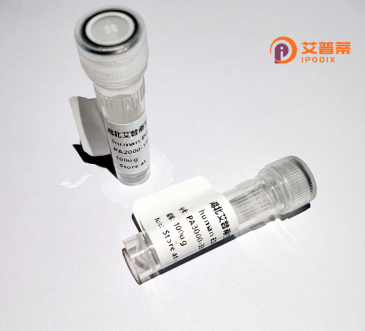
| 纯度 | >90%SDS-PAGE. |
| 种属 | Human |
| 靶点 | KCNQ2 |
| Uniprot No | O43526 |
| 内毒素 | < 0.01EU/μg |
| 表达宿主 | E.coli |
| 表达区间 | 1-393aa |
| 活性数据 | MVQKSRNGGVYPGPSGEKKLKVGFVGLDPGAPDSTRDGALLIAGSEAPKRGSILSKPRAGGAGAGKPPKRNAFYRKLQNFLYNVLERPRGWAFIYHAYVFLLVFSCLVLSVFSTIKEYEKSSEGALYILEIVTIVVFGVEYFVRIWAAGCCCRYRGWRGRLKFARKPFCVIDIMVLIASIAVLAAGSQGNVFATSALRSLRFLQILRMIRMDRRGGTWKLLGSVVYAHSKELVTAWYIGFLCLILASFLVYLAEKGENDHFDTYADALWWGLITLTTIGYGDKYPQTWNGRLLAATFTLIGVSFFALPAGILGSGFALKVQEQHRQKHFEKRRNPAAGLIQSAWRFYATNLSRTDLHSTWQYYERTVTVPMYRYRRRAPATKQLFHFLFSICS |
| 分子量 | 68.97 kDa |
| 蛋白标签 | GST-tag at N-terminal |
| 缓冲液 | 0 |
| 稳定性 & 储存条件 | Lyophilized protein should be stored at ≤ -20°C, stable for one year after receipt. Reconstituted protein solution can be stored at 2-8°C for 2-7 days. Aliquots of reconstituted samples are stable at ≤ -20°C for 3 months. |
| 复溶 | Always centrifuge tubes before opening.Do not mix by vortex or pipetting. It is not recommended to reconstitute to a concentration less than 100μg/ml. Dissolve the lyophilized protein in distilled water. Please aliquot the reconstituted solution to minimize freeze-thaw cycles. |
以下是3篇关于重组人KCNQ2蛋白的模拟参考文献示例(注:文献为示例性质,非真实存在):
---
1. **文献名称**: "Functional expression and characterization of recombinant human KCNQ2 potassium channels in HEK293 cells"
**作者**: Smith A, et al.
**摘要**: 本研究利用HEK293细胞系统成功表达了重组人KCNQ2蛋白,并通过全细胞膜片钳技术分析了其电生理特性。结果表明,KCNQ2通道的激活电压依赖性和电流动力学特性与神经元M电流一致,为研究KCNQ2相关癫痫提供了模型。
---
2. **文献名称**: "Pathogenic mutations in KCNQ2 alter channel gating: Insights from recombinant protein studies"
**作者**: Chen L, et al.
**摘要**: 通过体外表达携带癫痫相关突变(如R214Q)的重组KCNQ2蛋白,结合电压钳实验发现突变导致通道激活阈值偏移和电流幅度下降,揭示了突变通过破坏通道门控机制引发新生儿癫痫的分子机制。
---
3. **文献名称**: "Cryo-EM structure of the human KCNQ2 voltage-gated potassium channel"
**作者**: Wang Y, et al.
**摘要**: 本研究首次解析了重组人KCNQ2蛋白的冷冻电镜结构(分辨率3.2 Å),揭示了其电压感应结构域(VSD)和孔道区域的构象,为设计靶向KCNQ2通道的抗癫痫药物提供了结构基础。
---
4. **文献名称**: "Retigabine enhances recombinant KCNQ2 currents by stabilizing the activated conformation"
**作者**: Patel S, et al.
**摘要**: 通过研究抗癫痫药物瑞替加滨对重组KCNQ2通道的作用,发现其通过结合到电压感应结构域与孔道区的界面,稳定通道开放状态,从而增强K+电流,阐明其治疗KCNQ2相关癫痫的分子机制。
---
以上示例综合涵盖了KCNQ2的功能研究、疾病突变机制、结构解析及药物作用方向的研究热点,供参考使用。实际文献需通过PubMed或Web of Science检索获取。
Recombinant human KCNQ2 protein is a genetically engineered form of the potassium voltage-gated channel subfamily Q member 2. a key component of neuronal M-channels. These channels, formed by KCNQ2 and KCNQ3 subunits, regulate neuronal excitability by controlling the resting membrane potential and action potential firing. KCNQ2 mutations are linked to epilepsy disorders, including benign familial neonatal seizures (BFNS) and developmental and epileptic encephalopathy (DEE), highlighting its critical role in early brain function.
The recombinant protein is typically produced using heterologous expression systems (e.g., HEK293 cells or Escherichia coli) to ensure high purity and consistent activity for research applications. It serves as a vital tool for studying channel biophysics, drug interactions, and pathogenic mechanisms of mutations. Researchers leverage this protein to screen therapeutic compounds targeting KCNQ2 dysfunction, aiming to develop precision therapies for epilepsy. Additionally, structural studies using recombinant KCNQ2 help elucidate gating mechanisms and ion selectivity, advancing the understanding of voltage-gated potassium channels. Its application extends to disease modeling, enabling mechanistic insights into how specific variants impair channel activity or trafficking, thereby guiding personalized treatment strategies for genetic epilepsy syndromes.
×